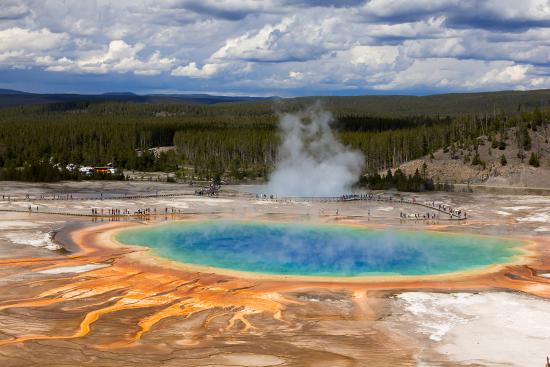


Midway Geyser Basin contains a small collection of mammoth-sized springs. Midway is part of the Lower Geyser Basin, but because of its isolated location between the main features of Lower and Upper geyser basins it became known as Midway. Rudyard Kipling, who visited Yellowstone in 1889, immortalized this basin by referring to it as "Hell's Half Acre." Even today it is still remembered by that name. Despite its small size Midway possesses two of the largest hot springs in the world. Grand Prismatic Spring, nearly 370 feet in diameter, sits upon a large mound surrounded by small step-like terraces. The other feature, Excelsior Geyser, erupted nearly 300 feet high before the 1900s. It is now a dormant geyser and is considered a hot spring, discharging more than 4050 gallons of boiling water per minute. Other colorful springs include Turquoise and Indigo springs, known for their pale and dark blue colors. Across the Firehole River from Excelsior and Grand Prismatic springs are a series of small isolated, pristine springs and mud pots. The Rabbit Creek drainage possesses some colorful and unusual features and most are unnamed. Caution should be exercised while exploring this vicinity since the ground is unstable and trails are not maintained.
Although Yellowstone National Park has a number of accessible boardwalks around geysers, mud pots and hot springs, the trail at Midway Geyser Basin offers the most variety. Located two miles south of the entrance to Firehole Lake Drive, there’s accessible parking near the trailhead, and accessible vault toilets at the far end of the parking lot. The mile-long boardwalk features a gradual slope, with level spots to stop and rest along the way. There are also a number of benches and wide viewing areas along the route that circles Excelsior Geyser, Turquoise Pool, Opal Pool and Grand Prismatic Spring – the largest hot spring in the park. If you only have time for one boardwalk trail, put this one at the top of the list. Be sure to stop by early in the day though, as the parking lot fills up quickly, especially on weekends; and it’s not unusual to see cars backed up on the main road waiting for parking spots later in the day.
EXCELSIOR GEYSER
Temperature 199°F Dimensions 276x328 feet. Excelsior was once the largest geyser In the world. However, the last known major eruptions occurred during the 1880s, when there were numerous eruptions up to 300 feet. The violent eruptions of the 1880s may have caused damage to the siliceous sinter lining, allowing gas leakage and the loss of thermal energy. No observed eruptions were known until 1985 when it erupted for two days. However, it only obtained a height of 20-80 feet. Since its eruptive activity in the 1880s, Excelsior is now a productive thermal spring, presently discharging 4050 gallons per minute. Numerous vents boil and churn the water within the crater, covering it in a dense layer of steam.
GRAND PRISMATIC SPRING
Temperature 147-188°F Dimensions 250x380 feet. Grand Prismatic is the largest hot spring in Yellowstone, and is considered to be the third largest in the world-New Zealand has the two largest springs. Grand Prismatic sits upon a wide, spreading mound where water flows evenly on all sides forming a series of small, stair-step terraces. The Hayden Expedition in 1871 named this spring because of its beautiful coloration, and artist Thomas Moran made water-color sketches depicting its rainbow-like colors. The sketches seemed exaggerations and geologist A.C. Peale returned in 1878 to verify the colors. The colors begin with a deep blue center followed by pale blue. Green algae forms beyond the shallow edge. Outside the scalloped rim a band of yellow fades into orange. Red then marks the outer border. Steam often shrouds the spring which reflects the brilliant colors. Grand Prismatic discharges an estimated 560 gallons per minute.
TURQUOISE POOL
Temperature 142-160°F Dimensions 100x110 feet. The 1878 Hayden Expedition named this pool for its milky, white bottom and gem-like, blue-colored water. Suspended mineral particles in the water also add an opalescent iridescence. Turquoise has no apparent overflow channel, instead water drains through seepage. There is an underground connection with Excelsior Geyser. When Excelsior was active, Turquoise lowered nearly ten feet and took nearly a year to recover. In June and July purple fringed gentians are common and bloom on the barren ground surrounding this pool.

